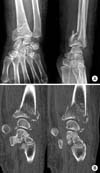Abstract
Purpose
The purpose of this study is to evaluate the incidence and characteristics of concomitant carpal bone fractures and ligament injuries and to analyze risk factors for carpal injuries in patients with distal radius fractures.
Materials and Methods
A total of 362 patients with 379 distal radius fractures were reviewed retrospectively. Associated carpal bone fractures and ligament injuries were evaluated by plain radiographs and computed tomography at the time of initial trauma. Correlation between associated carpal injuries and various parameters was also analyzed.
Results
Of 379 distal radius fractures, 39 cases (10.3%) had one or more carpal bone fracture and 40 cases (10.6%) had carpal ligament injuries. Overall, carpal injuries occurred in 59 cases (15.6%) distal radius fractures. Associated carpal ligament injuries showed correlation with young age and associated carpal bone fractures showed correlation with AO type B distal radius fractures. Carpal injuries including fracture and ligament injury showed correlation with male, high energy trauma, or associated injuries beyond wrist.
Figures and Tables
 | Fig. 1A 55-year-old female with a left distal radius fracture. (A) Plain radiographs show a comminuted fracture of the distal radius with widening of the scapholunate gap. (B) Computed tomography shows an avulsed fracture of the dorsal cortex of lunate. |
References
1. Kim BS, Ahn JH, Choy WS, Kim HY, Park JG. Scapholunate dissociation associated with distal radius fracture. J Korean Orthop Assoc. 2004; 39:265–270.

2. Heo YM, Kim SB, Yi JW, et al. Evaluation of associated carpal bone fractures in distal radial fractures. Clin Orthop Surg. 2013; 5:98–104.

3. Komura S, Yokoi T, Nonomura H, Tanahashi H, Satake T, Watanabe N. Incidence and characteristics of carpal fractures occurring concurrently with distal radius fractures. J Hand Surg Am. 2012; 37:469–476.

4. Kim JP, Park YH. Intercarpal ligament injuries associated with distal radius fractures: relation with the radiographic findings and arthroscopic treatment. J Korean Orthop Assoc. 2011; 46:294–302.

5. Chang CH, Tsai YS, Sun JS, Hou SM. Ipsilateral distal radius and scaphoid fractures. J Formos Med Assoc. 2000; 99:733–737.
7. Oskam J, De Graaf JS, Klasen HJ. Fractures of the distal radius and scaphoid. J Hand Surg Br. 1996; 21:772–774.

8. Rutgers M, Mudgal CS, Shin R. Combined fractures of the distal radius and scaphoid. J Hand Surg Eur Vol. 2008; 33:478–483.

9. Smith JT, Keeve JP, Bertin KC, Mann RJ. Simultaneous fractures of the distal radius and scaphoid. J Trauma. 1988; 28:676–679.

10. Kwon BC, Baek GH. Fluoroscopic diagnosis of scapholunate interosseous ligament injuries in distal radius fractures. Clin Orthop Relat Res. 2008; 466:969–976.

11. Laulan J, Bismuth JP. Intracarpal ligamentous lesions associated with fractures of the distal radius: outcome at one year. A prospective study of 95 cases. Acta Orthop Belg. 1999; 65:418–423.
12. Mudgal C, Hastings H. Scapho-lunate diastasis in fractures of the distal radius. Pathomechanics and treatment options. J Hand Surg Br. 1993; 18:725–729.
13. Richards RS, Bennett JD, Roth JH, Milne K Jr. Arthroscopic diagnosis of intra-articular soft tissue injuries associated with distal radial fractures. J Hand Surg Am. 1997; 22:772–776.

14. Rosenthal DI, Schwartz M, Phillips WC, Jupiter J. Fracture of the radius with instability of the wrist. AJR Am J Roentgenol. 1983; 141:113–116.

15. Schneiders W, Amlang M, Rammelt S, Zwipp H. Frequency of acute and chronic scapholunate dissociation in distal radius fractures. Different treatment plans. Unfallchirurg. 2005; 108:715–720.

16. Tang JB. Carpal instability associated with fracture of the distal radius. Incidence, influencing factors and pathomechanics. Chin Med J(Engl). 1992; 105:758–765.
17. Tang JB, Shi D, Gu YQ, Zhang QG. Can cast immobilization successfully treat scapholunate dissociation associated with distal radius fractures? J Hand Surg Am. 1996; 21:583–590.

18. Fotiadou A, Patel A, Morgan T, Karantanas AH. Wrist injuries in young adults: the diagnostic impact of CT and MRI. Eur J Radiol. 2011; 77:235–239.





 PDF
PDF ePub
ePub Citation
Citation Print
Print




 XML Download
XML Download